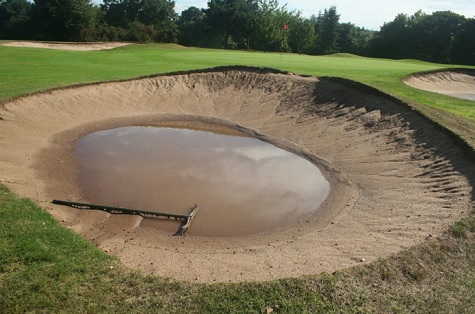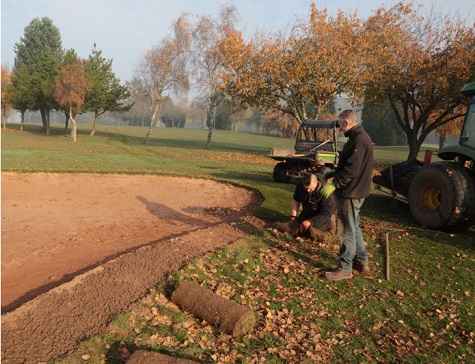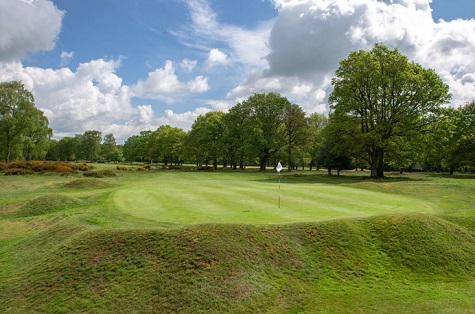As an ex-greenkeeper, I am only too aware of the many issues a professional faces when trying to keep their course playable and maintained through the depths of winter - a task not helped by the extra work that storms and wet weather can bring at this time of the year. One of the most challenging issues is heavy downpours causing your bunkers to become flooded resulting in the sand washing away.
Bunkers for many greenkeepers are the bane of their lives, requiring constant attention every day. This can often be one of the club’s most labour-intensive tasks throughout the year.
In recent times we have seen improvements to bunker design and construction methods that have improved the aesthetics and performance of the hazards. At Cocksmoors Woods Golf Course in Birmingham where I worked as a greenkeeper in the 1980s, we had 53 bunkers that needed to be raked and maintained.

Flooded bunker at Blackwell GC
UK courses tend to have anything between 40-120 bunkers to maintain. I read a recent article that the Grove GC had, during the lockdown period, refurbished all their bunkers.
The work was undertaken across an intensive 10-week period that saw the team re-address bunker shaping, repair damaged edges, review grassing lines and re-affirm mown and natural areas surrounding each trap.

Newly constructed bunkers at The Grove GC
Golf Business News said the course stayed open for play during the whole process, with three holes being worked on at any one time with a temporary green being used on each, while ground staff undertook the necessary work.
Phill Chiverton, golf course manager at The Grove, says in the piece, “A project of this scale, and over such a relatively short period of time, took a huge amount of planning, resources, machinery and turf in order to be completed successfully, and on time. Our team worked on an average of 1.8 bunkers a day which is incredible, considering the adverse winter weather conditions we experienced.”
No doubt this work came at a considerable cost as most newly constructed bunkers have intensive drainage and lined porous bases, and the cost of sands can be high.
New methods
In the last ten to fifteen years we have seen a plethora of new bunker construction materials and techniques being introduced into the industry. Sand alone is now being sold at anything between £40-£100 per tonne, plus delivery costs, and generally sand will need constant replacing over time.
Design, alignment, placement and maintenance of bunkers over the years has become a complex and costly activity. There has always been much debate on these features. There are plenty of questions to be considered when dealing with bunkers, of which seven can be read in this GCM article.

Re-edging bunkers at Lilleshall GC
However, having spoken to a number of greenkeepers and golf architects there will always be an interesting debate on the merits of bunkers, their upkeep and maintenance.
I enjoyed reading the thoughts of Jonathan Gaunt in an article he had published that asked the question, Are modern courses being built with bunkers just because it's the right thing to do rather than an important feature of the course?
Jonathan Gaunt says that today they are being asked to:
- reduce the number of sand bunkers
- reduce the sand areas down to reduce maintenance costs
Jonathan says, "We’re proposing, generally, the removal of near right and left greenside flanking bunkers and replacing them with run-off swales and grassy hollows.one well placed bunker can easily do the job of several poorly placed ones.

Well maintained Bunkers at Enville GC
"If you ask a club member in the UK whether a golf course could be considered a good golf course without bunkers, the majority would, almost certainly, say no.
"However, there are some excellent (hidden) examples of great golf courses without bunkers - Huntercombe, Royal Ashdown and Piltdown to name but a few - where other hazards, such as heather, grassy hollows and ditches work equally well as protection from attack."
Another golf course that has no bunkers is Berkhamsted, a true heathland golf course, which uses grass, and not sand, as its natural defences. Bunkers are expensive to maintain and in many cases are not part of the natural environment, and by not havng them at all Berkhamsted says it is setting an example to the world’s golf course architects.

Bunkerless Berkhamsted GC
I personally think that a golf club should be asking the question, ‘do we really need that many bunkers or can we find alternative ways of creating hazards and enhancements to improve aesthetics and playability?’
I believe there are many respected golf course architects and course managers that can now conjure up a hazard or feature that can work as well, if not better, than a sand bunker.
It will be interesting to see how many golf courses in the coming years change their opinion on the placement and management of these time-consuming, sand-based hazards.